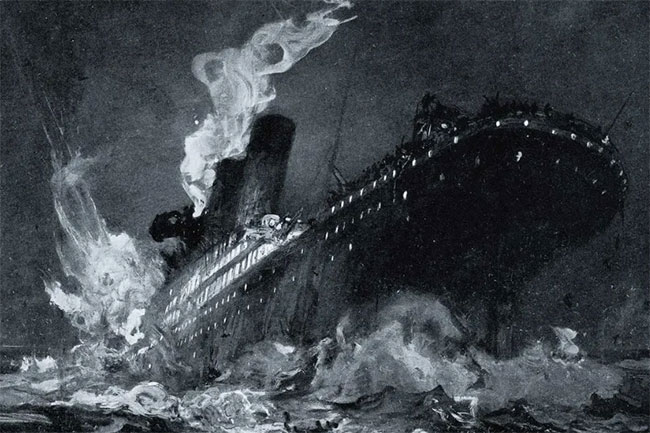This is the truth about the 'culprit' that sank the Titanic, causing the most famous maritime disaster in history
The ice block that sank the legendary ship was about 3 years old, and is expected to only be "alive" a few weeks after it collided with the ship.
It is a special iceberg that appeared in the summer of 1909, more than 3.2 km wide and more than 30 meters high at the time of its birth. The Titanic was conceived with the ambition to compete in size and luxury, being the largest passenger ship ever known.
The titanic was built over three years, designed by the White Star Line with two sister ships, the Olympic (1911) and the slightly larger Britannic (1915). They were designed with the rich, famous, well-connected across the Atlantic in ornate cabins with Victorian amenities.
The highest fare on board the Titanic, equivalent to about $60,000 today, entitles passengers to an upscale dining room, oak-paneled meeting room, Turkish bath, saltwater swimming pool, giant bay windows and mobile orchestra.

Painting of the Titanic collapsing when it hit an iceberg.
The ship rolled off a shoal in Northern Ireland in early 1912, stopping to pick up passengers at Cherbourg, France, and Queenstown, Ireland, before turning west to New York. According to records, the ship was carrying more than 2,200 people, more than a third of them were crew, most of them were gone forever, only 710 survived.
At that time, people knew very little about the workings of icebergs, except that most of the icebergs had melted. John Thomas Towson, a scientist specializing in ship navigation who wrote a book called Facts about Compass Deviations, remarked in 1857 that these icebergs were no different. The rock was formed over millennia by time and pressure. He argues that icebergs pose an existential danger to the wooden hulls of nineteenth-century ships. An extremely large number of icebergs drifted south across the strait east of the Grand Banks in eastern Newfoundland for which in 191, it was nicknamed the "ice canyon".
For 3 years, the icy mass undulated and intertwined in the Arctic waters. At some point, it moved northward and spent the summer of 1910 further northward. Continuing, it would meet the Labrador Current, which carries the frozen water southward. Most icebergs drift within the first year they form. Finally, the Labrador Current meets the warm waters of the Gulf Stream, which acts like an ocean microwave.
Only 1% of the icebergs in the Northern Hemisphere survive this desert, and only about 1/1000 of the icebergs reach 41 degrees North, about the same latitude as New York City and right in the path of the desert. transatlantic ship.

The Titanic on the bottom of the ocean
When the Titanic sank in 1912, it plunged a staggering distance of more than 2 miles, hitting the seabed at a speed of more than 3 miles per hour. The catacombs on the ocean floor were so remote that the ship's location remained a mystery until 1985, when a team exploring government submarines and vehicles was able to capture some blurry photos. Thus, it took more than 70 years to find the famous shipwreck.
The sinking of the Titanic has been widely known, repeated and re-enacted in films, books, museum exhibits, consumer products and television specials. However, it is easy to forget the most astonishing detail about the "culprit" iceberg. The iceberg that struck and brought down the largest passenger ship ever built is also almost gone. After about 3 years of existence, this frozen block can only survive about 2 weeks since it caused the disaster.
The ice floes get smaller as they enter warmer waters, but they grow heavier and flip more, eroding until they reach the size of a basketball, which they keep flipping until they don't. what else.
According to estimates, there are more icebergs today than there were when the Titanic existed. However, advances in radar, GPS and aircraft surveillance, along with larger and better designed ships, have reduced the risk of icebergs to shipping.
But there are still icebergs that become a major threat. In 2007, a small cruise ship near Antarctica called the MS Explorer was hit by an unseen iceberg. Fortunately, passengers rushed to lifeboats and were rescued by another nearby cruise ship a few hours later.
- The iceberg sank the Titanic with a lifespan of 100,000 years
- Those who chew the Titanic wreck
- April 14, 1912: The Titanic crashed into the iceberg, the most horrific accident in maritime history
- Reveal the last great mystery about the Titanic disaster
- The largest legacy is left when the Titanic sank into the ocean
- The mysterious story of the six Chinese who survived the sinking of the Titanic
- Little-known mysteries about the legendary Titanic
- Story of 9 people who survived the Titanic disaster
- The Titanic is in distress
- Announcing the cause of the tragedy sinking the Titanic
- Strange theories about the Titanic disaster
- Thousands of degrees of fire could be the culprit for sinking the Titanic
 Biography of hero Vu A Dinh
Biography of hero Vu A Dinh History of hematology
History of hematology Who is Mr. Tam Da 'Phuc-Loc-Tho' and what does it mean?
Who is Mr. Tam Da 'Phuc-Loc-Tho' and what does it mean? Unbelievable facts about the history of the oil and gas industry: Gasoline used to be cheaper than water, so abundant that it had to be dumped into the river...
Unbelievable facts about the history of the oil and gas industry: Gasoline used to be cheaper than water, so abundant that it had to be dumped into the river...